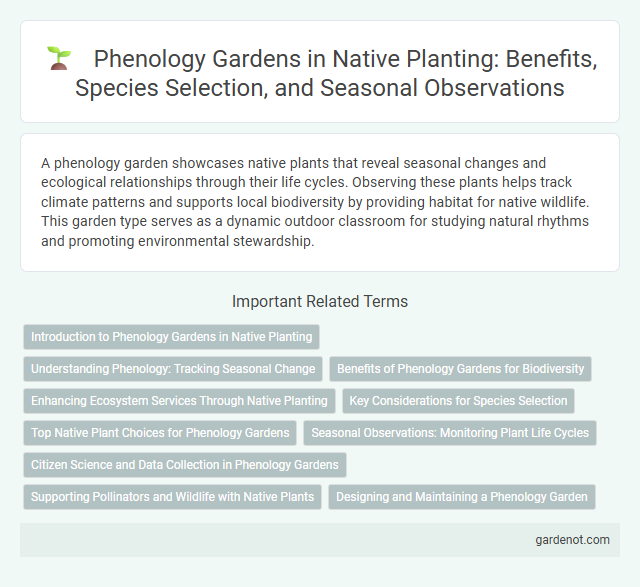A phenology garden showcases native plants that reveal seasonal changes and ecological relationships through their life cycles. Observing these plants helps track climate patterns and supports local biodiversity by providing habitat for native wildlife. This garden type serves as a dynamic outdoor classroom for studying natural rhythms and promoting environmental stewardship.
Introduction to Phenology Gardens in Native Planting
Phenology gardens in native planting showcase the timing of natural events such as flowering, leafing, and fruiting, helping observers track seasonal changes and climate impacts. These gardens emphasize native species adapted to local ecosystems, promoting biodiversity and ecological resilience. Monitoring phenological stages supports conservation efforts and informs sustainable landscape management practices.
Understanding Phenology: Tracking Seasonal Change
Phenology gardens play a crucial role in understanding the timing of natural events such as leaf emergence, flowering, and fruiting in native plants. By systematically tracking these seasonal changes, researchers can monitor the impact of climate fluctuations on local ecosystems. This data helps inform conservation strategies and supports biodiversity by highlighting critical periods in plant life cycles.
Benefits of Phenology Gardens for Biodiversity
Phenology gardens enhance biodiversity by tracking seasonal changes in native plant life, supporting pollinators and wildlife habitats through precise planting schedules. These gardens foster resilience in ecosystems by promoting native species adapted to local climate patterns, aiding in conservation efforts. Monitoring phenological data helps scientists understand environmental shifts, guiding sustainable management of native plant communities.
Enhancing Ecosystem Services Through Native Planting
Phenology gardens featuring native plants improve ecosystem services by supporting local wildlife, enhancing pollination, and regulating microclimates. These gardens promote seasonal observation of plant and insect life cycles, fostering biodiversity and increasing pollinator habitat connectivity. Native species selection in phenology gardens strengthens soil health, aids carbon sequestration, and supports natural water filtration processes.
Key Considerations for Species Selection
Selecting species for a Phenology garden requires attention to native plant adaptability, ensuring plants thrive within the local climate and soil conditions. Prioritize species that exhibit distinct seasonal changes, such as flowering or leaf-drop timings, to effectively track phenological events. Incorporate a diverse range of plants that support local wildlife and enhance ecological resilience throughout the year.
Top Native Plant Choices for Phenology Gardens
Phenology gardens thrive with top native plant choices such as Eastern Redbud (Cercis canadensis), Black-eyed Susan (Rudbeckia hirta), and Pawpaw (Asimina triloba), which provide essential data on seasonal changes in plant life cycles. These native species support local ecosystems by attracting pollinators and offering habitat while serving as reliable bioindicators for climate and environmental shifts. Incorporating a diverse range of native perennials, shrubs, and trees enhances the accuracy of phenological observations and enriches garden biodiversity.
Seasonal Observations: Monitoring Plant Life Cycles
Phenology gardens provide crucial data by tracking seasonal changes in native plant life cycles, such as leaf emergence, flowering, and fruiting times. Monitoring these stages helps scientists understand the impacts of climate change on local ecosystems and biodiversity. Detailed observations guide conservation efforts and inform native planting strategies to support resilient habitats.
Citizen Science and Data Collection in Phenology Gardens
Phenology gardens engage citizen scientists to monitor seasonal changes in native plant species, collecting valuable data on flowering times, leaf emergence, and fruiting. This community-driven data collection strengthens ecological research and enhances understanding of climate impacts on plant development cycles. Integrating native planting in phenology gardens supports biodiversity while providing essential datasets for long-term environmental monitoring.
Supporting Pollinators and Wildlife with Native Plants
A Phenology garden featuring native plants provides essential habitats for pollinators such as bees, butterflies, and hummingbirds by offering continuous blooms matched to local seasonal patterns. Incorporating diverse native species ensures a reliable food source and nesting sites for wildlife, enhancing ecosystem resilience and biodiversity. Monitoring plant phenophases helps track climate impacts while optimizing garden health and wildlife support throughout the year.
Designing and Maintaining a Phenology Garden
Designing a phenology garden requires selecting native plants with varied bloom times to track seasonal changes accurately. Maintaining the garden involves regular monitoring of plant developmental stages, such as flowering, leaf-out, and fruiting, ensuring data collection reflects climate patterns. Incorporating species adapted to local soil and climate conditions enhances the garden's resilience and ecological value.
Phenology garden Infographic

 gardenot.com
gardenot.com